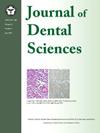Efficacy and safety of infiltration anesthesia with 4 % Articaine and block anesthesia with 2 % Lidocaine in the mandibular third molar extraction
IF 3.4
3区 医学
Q1 DENTISTRY, ORAL SURGERY & MEDICINE
引用次数: 0
Abstract
Background/Purpose
Articaine is a dental anesthetic that has been developed and widely used in recent years. This study aimed to compare the anesthetic efficacy and safety of infiltration anesthesia with 4 % Articaine (with 1:100,000 epinephrine) and block anesthesia with 2 % Lidocaine (with 1:100,000 epinephrine) in the mandibular third molar extraction.
Materials and methods
This prospective, randomized, split-mouth clinical trial was planned to involve 30 adults with the bilateral mandibular third molars. Participants were randomly assigned to receive 4 % Articaine (Articaine group) by infiltration anesthesia on one side and 2 % Lidocaine (Lidocaine group) by block anesthesia on the opposite side. Parameters such as the heart rate, blood pressure, oxygen saturation, anesthetic usage, operation duration, pain score, satisfaction, and adverse events were recorded and analyzed.
Results
Finally, 26 participants receiving the bilateral mandibular third molar extraction were included. There were no significant differences in the heart rate, blood pressure, oxygen saturation, and maximum fluctuations during the extraction procedure between the two groups, except the maximum heart rate fluctuation showing statistical significance. Additionally, the amount of anesthetic used was significantly lower in the Articaine group (1.5 ± 0.4 cartridges) than in the Lidocaine group (2.2 ± 0.5 cartridges) (P < 0.001). There were no significant differences in the operation duration, pain score, and satisfaction between the two groups, and no adverse events were reported in either group.
Conclusion
Using 4 % Articaine for infiltration anesthesia offers comparable pain control to 2 % Lidocaine for block anesthesia in the mandibular third molar extraction surgery. Using 4 % Articaine can safely achieve similar pain control with lower doses and less invasive anesthesia techniques.
求助全文
约1分钟内获得全文
求助全文
来源期刊

Journal of Dental Sciences
医学-牙科与口腔外科
CiteScore
5.10
自引率
14.30%
发文量
348
审稿时长
6 days
期刊介绍:
he Journal of Dental Sciences (JDS), published quarterly, is the official and open access publication of the Association for Dental Sciences of the Republic of China (ADS-ROC). The precedent journal of the JDS is the Chinese Dental Journal (CDJ) which had already been covered by MEDLINE in 1988. As the CDJ continued to prove its importance in the region, the ADS-ROC decided to move to the international community by publishing an English journal. Hence, the birth of the JDS in 2006. The JDS is indexed in the SCI Expanded since 2008. It is also indexed in Scopus, and EMCare, ScienceDirect, SIIC Data Bases.
The topics covered by the JDS include all fields of basic and clinical dentistry. Some manuscripts focusing on the study of certain endemic diseases such as dental caries and periodontal diseases in particular regions of any country as well as oral pre-cancers, oral cancers, and oral submucous fibrosis related to betel nut chewing habit are also considered for publication. Besides, the JDS also publishes articles about the efficacy of a new treatment modality on oral verrucous hyperplasia or early oral squamous cell carcinoma.
 求助内容:
求助内容: 应助结果提醒方式:
应助结果提醒方式:


